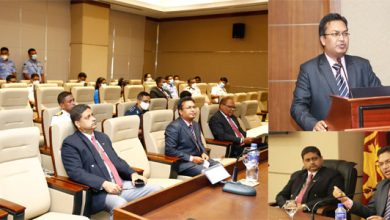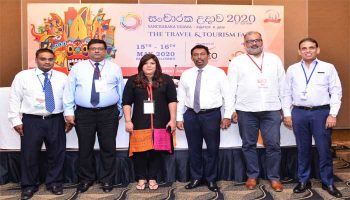Angampora: a martial arts form unique to Sri Lanka
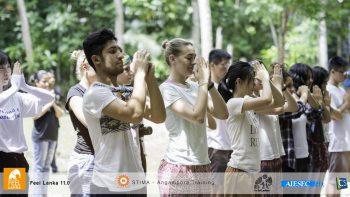
Students of the University of Moratuwa who are the members of Feel Lanka a project organized by AIESEC to promote Sri Lanka’s tourism, visited the Sri Lankan Traditional Indigenous Martial Art Association(STIMA) in order to find details about Angampora, the unique martial art, that is regarded as an important phenomenon of Sri Lanka’s history and heritage.
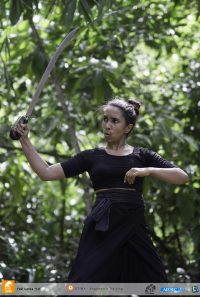 They were introduced to Angampora by the members of STIMA who described the history and also the uniqueness and intricacies linked to Angampora.
They were introduced to Angampora by the members of STIMA who described the history and also the uniqueness and intricacies linked to Angampora.
Describing what they observed while witnessing the verbal and practical aspects displayed by members of STIMA they filed this report to the Ceylon Digest.
In the rich folds of Sri Lankan culture lies one of the most important and unique practices in the country; the martial art of Angampora. It is an indigenous practice that was passed down from generations of ancient kings, warriors and ordinary citizens to serve the purpose of protecting the nation from foreign invaders. This form of martial art combines elements of physicality, spirituality and the mind to assemble a craft of combat unique to Sri Lanka.
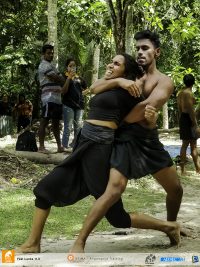 The origins of this art are buried in history, yet many sources attribute its genesis to different eras. According to the Sinhalese folklore, Angampora stretches back to 33000 years within the Yaksha, one of the tribes that inhabited the region at the time. While, some evidence found in the Varga Purnikawa and Pancha Rakkhawaliya manuscripts identify the nine hermits as the main originators of the tradition, other sources date its creation back to the Anuradhapura era, where it was employed as a combat strategy by the nobles. It is also believed that Angampora reached an optimal point during the age of king Ravana, the most feared angam warrior, who’s paid tribute until this day by some angam performers, who light a lamp in his memory before every session.
The origins of this art are buried in history, yet many sources attribute its genesis to different eras. According to the Sinhalese folklore, Angampora stretches back to 33000 years within the Yaksha, one of the tribes that inhabited the region at the time. While, some evidence found in the Varga Purnikawa and Pancha Rakkhawaliya manuscripts identify the nine hermits as the main originators of the tradition, other sources date its creation back to the Anuradhapura era, where it was employed as a combat strategy by the nobles. It is also believed that Angampora reached an optimal point during the age of king Ravana, the most feared angam warrior, who’s paid tribute until this day by some angam performers, who light a lamp in his memory before every session.
Angampora survived the passage of time and the luck of the reigns of Sinhala, serving also as an effective method of defense against the Portuguese and Dutch invaders. However, in 1817 the British colonialists released a gazette banning the practice of Angampora among Sri Lankans with hard punishments as consequences to breaching the ban. This may have induced a plummet in the practice of Angampora, however some families continued to practice in secret ensuring the preservation of the tradition.
The practice starts generally with a session of meditation and a warm up session Later they commence the practice session of unarmed combat which is the advised type of the discipline for beginners among two other types; armed combat and spiritual meditation. The participants were then paired up and guided through the routine.
Many of the prominent martial arts performances today are known for their defensive strategies. In contrast, Angampora is known as an approach based on offense. The discipline is designed to kill or paralyze the opponent, the attacks are very lethal leading to complete paralysis or death.
Angampora has been taught to the ancient Sri Lankan army, yet it is more fitting for guerilla style attacks that were adopted by the Sri Lankans while liberating their land from repeated invasions throughout the history. The moves and attacks are four sided, as required in a real battlefield. Hence, Angampora performers are able to fight multiple opponents at once in comparison to other martial art styles that focus on only one opponent.
Angampora – STIMA is an association, founded by Guru Piumal Edirisinghe, that teaches Angampora to locals and tourists to preserve the martial art for future generations. The members of Angampora – STIMA are volunteers bound by the passion for the art and want to see it thrive in modern Sri Lanka. The members dedicate their free time and weekends to work for the association as a way of paying their respects to an art form that has been a part of their lives and culture. The institute teaches Angampora in a natural environment where they use traditional weapons, eat traditional food and wear the traditional clothes. For more details: www.angampora.com/
Angampora is one of the exceptional attractions that will lure the tourists who are inquisitive seekers of Sri Lanka’s hidden treasures other than wild life, beaches and warm environment.
(Contributed by: Guo Ying Ying( HongKong), Maryam Alajimi(Baharain), Shahd Magouri(Libya) All members of AIESEC)




